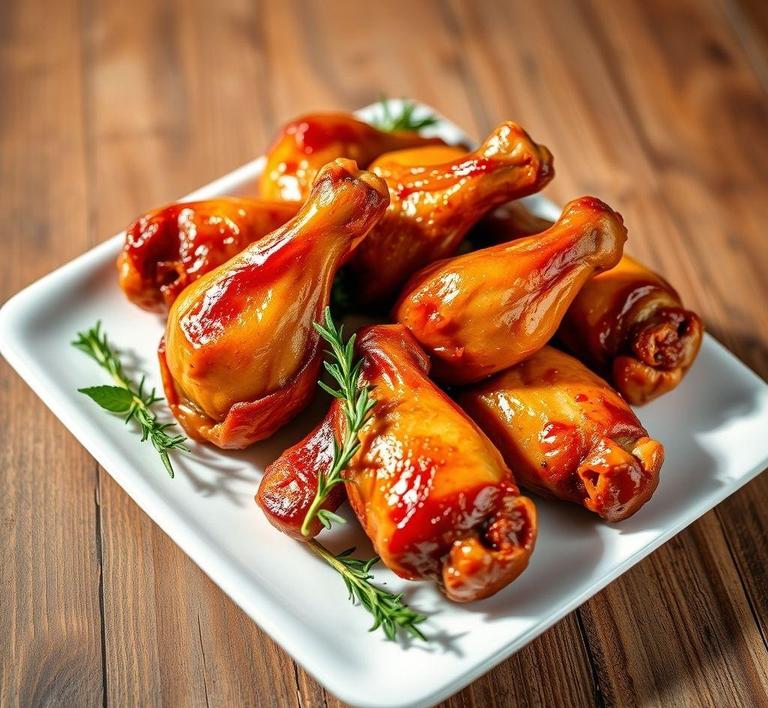So, you’ve cooked up a batch of turkey wings and ended up with leftovers? No worries! Refreezing turkey wings can be a handy way to preserve them for later, but there are a few things you should know to make sure they stay fresh and safe to eat. In this guide, we’ll walk you through the best way to refreeze turkey wings, whether they’re cooked or raw, and share tips on how to maintain their flavor and texture. By following these simple steps, you can enjoy your turkey wings long after dinner is over, without worrying about any freezer burn or spoilage!
Can You Refreeze Turkey Wings?

The question of whether you can refreeze turkey wings is not just a matter of convenience; it’s also tied to food safety and quality concerns. Turkey wings, like many other types of poultry, are highly susceptible to bacterial growth, especially once they’ve been thawed. This is a crucial factor to consider when deciding whether to refreeze them. So, yes, you can refreeze turkey wings-but only under certain conditions.
When turkey wings are thawed in the fridge, they are at a safe temperature (usually around 40°F or below) that inhibits the rapid growth of harmful bacteria. In this case, as long as the turkey wings have been handled properly and haven’t been left at room temperature for extended periods, it’s possible to refreeze them. However, if they have been thawed in a manner where they’ve been exposed to temperatures above 40°F for more than two hours (such as being left out on the counter or thawed in hot water), refreezing them becomes risky. In this case, refreezing would not be recommended due to the potential for bacterial contamination.
The FDA’s guidelines specifically mention that it’s safe to refreeze poultry if it was thawed in the fridge or under cold running water, and if it has been cooked in the meantime. Refreezing raw turkey wings that were thawed in the fridge (and not left out) is generally safe. The key factor is ensuring the wings have never been exposed to the ‘danger zone’ of temperatures (between 40°F and 140°F), where bacteria grow most rapidly.
How To Refreeze Turkey Wings?
If you’ve decided to go ahead and refreeze your turkey wings, it’s essential to take some careful steps to maintain food safety and quality. Here’s a step-by-step guide to ensure you do it properly:
- Check the Condition of the Turkey Wings: Before refreezing, inspect the turkey wings. If they have been left out at room temperature for more than two hours, or if they seem off (sour smell, slimy texture), it’s safer to discard them. If they’ve been thawed in the fridge and still seem fresh, you can proceed.
- Ensure They Are Cooled Completely: If the turkey wings have been cooked or heated after thawing, allow them to cool to room temperature. Hot or warm poultry can raise the temperature of your freezer, potentially putting other frozen foods at risk. It’s important to cool the wings down completely to avoid this.
- Wrap Them Well: Proper packaging is critical. Wrap the turkey wings tightly in plastic wrap, aluminum foil, or vacuum-sealed bags to prevent freezer burn. Freezer burn can affect the texture and flavor of the meat, causing it to dry out and become tough. Vacuum sealing is the most effective method to keep air out and preserve the turkey’s quality.
- Label and Date: This is often an overlooked step, but it’s important. Label the package with the date when the turkey wings were initially frozen. This will help you keep track of how long they’ve been stored, as refrozen turkey wings are best consumed within 2-3 months for optimal quality.
- Place in the Freezer Quickly: Once wrapped and labeled, place the turkey wings in the coldest part of the freezer to refreeze. The faster they freeze, the better they’ll maintain their texture and flavor.
Quality Impact
Refreezing turkey wings does come with a trade-off in quality. While it may be safe to do so under the right circumstances, the texture and flavor of the meat can suffer. Here’s why:
- Loss of Moisture: Each time meat is frozen and thawed, some of its moisture is lost. This is especially true for poultry, which has a high water content. Upon thawing, some of this moisture leaks out, and refreezing it can exacerbate this issue. As a result, turkey wings may become drier and less tender after being refrozen.
- Texture Changes: The freezing process causes ice crystals to form within the meat’s cells. When meat is thawed and refrozen, these ice crystals can damage the cell structure further, resulting in a mushier texture when cooked.
- Flavor Degradation: Freezing and refreezing turkey wings can also impact the flavor. While it may not drastically alter the taste, the meat may lose some of its natural juiciness and richness. Additionally, freezer burn-caused by exposure to air-can result in off-flavors and dry, unappetizing patches on the wings.
- Risk of Bacteria Growth: If turkey wings are not properly handled before refreezing, there’s a risk of bacteria growth, especially if the wings have been thawed improperly or left out too long. If this happens, no matter how much they’re refrozen, there’s a chance of contamination, which could lead to foodborne illnesses.
Refreezing turkey wings is definitely possible, but it requires a careful and informed approach. If the turkey wings have been thawed in the refrigerator and handled properly, then refreezing them should be safe. However, it’s essential to understand that doing so will likely compromise their quality, leading to a loss in moisture, texture, and possibly flavor. To maintain the best eating experience, you should aim to cook and eat the turkey wings as soon as possible after they’re thawed.
If you’re in a situation where you’ve thawed more turkey wings than you can use or don’t want to risk spoilage, refreezing is an option, but it’s important to follow the correct steps. Ensure they are packed well, labeled, and consumed within a few months to avoid any food safety issues or significant quality decline.
Ultimately, while refreezing is an option, always prioritize safety and quality. If in doubt, it’s often better to cook the turkey wings first and then freeze the cooked meat to preserve it better than refreezing raw poultry. By taking these precautions, you can reduce waste and still enjoy your turkey wings later.
Is It Safe To Refreeze Turkey Wings?
Refreezing turkey wings is a topic that often sparks debate among home cooks, and with good reason. While it might seem like a convenient way to extend the shelf life of your meat, it’s essential to understand the potential risks involved.
In general, refreezing cooked turkey wings is considered safe, but it depends on how the turkey was handled before and during the freezing process. The USDA guidelines recommend that food should only be refrozen if it has been thawed in the refrigerator and not left at room temperature for extended periods. When thawing turkey wings (or any other meat), it’s crucial to do so in a controlled environment to avoid harmful bacteria growth. If the wings were initially frozen, then fully thawed in the refrigerator, and not left out for more than two hours at room temperature, they can be safely refrozen.
However, the texture and quality of the wings may degrade with each freeze-thaw cycle. This happens because ice crystals form and rupture the cell walls of the meat, leading to a loss of moisture and causing the wings to become tougher or drier. Refreezing also increases the chances of freezer burn, which affects both flavor and texture.
It’s essential to keep in mind that raw turkey wings should not be refrozen after they have thawed. If raw turkey is thawed and then left at room temperature for more than two hours, bacteria such as Salmonella or Campylobacter could begin to multiply rapidly, posing a significant food safety risk. Once these bacteria are present, refreezing doesn’t kill them; it only halts their growth temporarily until the meat is thawed again. Therefore, it’s safer to cook the wings first and then freeze them if you plan on refreezing.
Signs That Turkey Wings Should Not Be Refrozen
Even though refreezing turkey wings can be safe under the right conditions, it’s important to recognize the signs that indicate the meat has gone bad and should not be refrozen.
- Unpleasant Odor: One of the most obvious signs that turkey wings should not be refrozen is a foul or sour smell. Turkey, like all poultry, is prone to spoilage due to bacterial growth. If you notice any rancid or off-putting smells, it’s best to discard the wings.
- Slimy or Sticky Texture: Turkey wings should have a smooth texture. If they become sticky or develop a slimy coating, it means they’ve started to spoil. The sliminess is a result of bacteria breaking down the meat’s proteins, and refreezing them could lead to foodborne illness.
- Discoloration: Healthy turkey wings should be pale pink to white in color. Grayish, greenish, or yellowish discoloration is a sign that the wings are no longer safe to eat. This could be a result of bacteria or oxidation, and refreezing would not make the meat safe to consume.
- Freezer Burn: If the wings have been improperly packaged or stored for too long in the freezer, they may develop freezer burn. This occurs when air comes into contact with the meat and dries it out, leading to whitish or grayish patches. Although freezer-burned turkey wings are not unsafe to eat, they will be dry and unappetizing, and refreezing won’t improve the texture or flavor.
- Improper Thawing: If the turkey wings were thawed improperly (for example, left out at room temperature for more than two hours), they should not be refrozen, as harmful bacteria may have multiplied to unsafe levels. In this case, it’s best to discard the wings to avoid the risk of foodborne illness.
Common Refreezing Mistakes
When it comes to refreezing turkey wings (or any poultry), there are a few common mistakes that many people make. These missteps can lead to unsafe meat or poor-quality meals, so it’s important to be aware of them.
- Thawing at Room Temperature: One of the biggest mistakes is allowing turkey wings to thaw at room temperature. This creates an environment where bacteria can grow rapidly. The USDA recommends thawing frozen turkey wings in the refrigerator or in cold water to maintain safety. Room temperature thawing can result in a major food safety hazard, and the wings should be discarded if they were thawed in this manner.
- Refreezing Without Cooking: Refreezing raw turkey wings after they have been thawed is another mistake. Raw meat, especially poultry, can harbor harmful bacteria like Salmonella, which grows rapidly once the meat is thawed. Refreezing won’t kill the bacteria; it just pauses their growth until the meat is thawed again. Always cook the turkey wings before refreezing to kill any potential pathogens.
- Not Packaging Properly: When you freeze turkey wings, they must be tightly wrapped or placed in airtight containers. If air gets to the meat, it can lead to freezer burn, which negatively impacts the flavor and texture. Many people make the mistake of loosely wrapping their wings or storing them in containers that aren’t air-tight. The best practice is to use plastic wrap, foil, or vacuum-sealed bags to keep air out and preserve quality.
- Freezing Too Long: While turkey wings can last in the freezer for several months, they don’t stay in optimal condition indefinitely. Freezing turkey wings for too long-beyond the recommended 6-12 months-can result in decreased texture and flavor. After a certain period, the meat’s quality will deteriorate, and even refreezing won’t help.
- Multiple Freeze-Thaw Cycles: Continuously thawing and refreezing turkey wings can lead to severe degradation in texture and flavor. Each time they thaw, ice crystals form and rupture the muscle fibers, causing moisture loss and making the wings dry and tough. The more cycles they go through, the more compromised their quality becomes.
Tips And Tricks For Refreezing Turkey Wings
To make sure your turkey wings remain safe and tasty when refrozen, there are some practical tips and tricks you can follow:
- Cook Before Refreezing: Always cook the turkey wings first before freezing if you want to ensure their safety. This eliminates the risk of bacteria from raw poultry and helps preserve flavor and texture. Cooked turkey wings freeze better because they retain moisture better than raw wings.
- Use Vacuum Sealing: The best method to preserve turkey wings in the freezer is to vacuum seal them. This prevents air exposure, which can lead to freezer burn. If you don’t have a vacuum sealer, use freezer-safe bags and remove as much air as possible before sealing.
- Label and Date: Always label your packages with the date they were frozen. This helps you keep track of how long they’ve been in the freezer and ensures you use them within the recommended timeframe. This also prevents the issue of keeping meat in the freezer for too long.
- Portion Control: When freezing turkey wings, portion them out into smaller, meal-sized packages. This allows you to thaw only the amount you need, without refreezing the leftovers each time. The less you refreeze, the better the quality will remain.
- Rapid Freezing: When freezing cooked turkey wings, try to freeze them as quickly as possible. The faster the freezing process, the smaller the ice crystals will be, which helps prevent damage to the meat’s texture.
Conclusion
Refreezing turkey wings can be safe, but it’s essential to follow proper guidelines to ensure both food safety and optimal quality. Always make sure the turkey is thawed correctly in the refrigerator, and avoid leaving it at room temperature for extended periods. Cooked turkey wings are easier to refreeze than raw ones, as cooking kills any bacteria present. Remember, though, that repeated freeze-thaw cycles will affect the texture and moisture of the wings, so it’s important to avoid doing so unless absolutely necessary.


